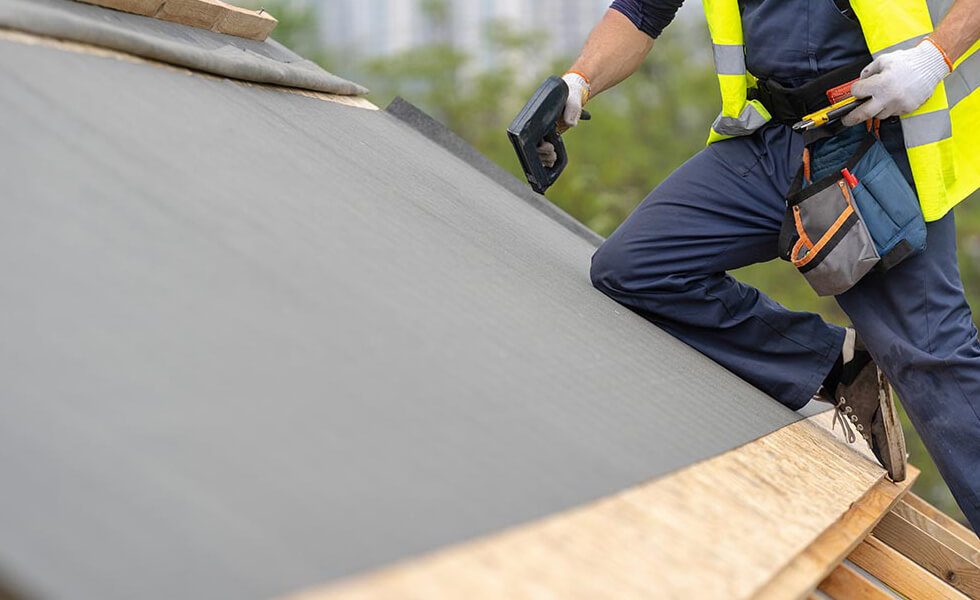Roofing Underlayment is part of the roofing process. Underlayment is under the shingles or tiles, which is part of every roofing job; it is an essential part of the roof’s structure. When making decisions on this component of the job, consumers have to look at synthetic vs. felt underlayment.
Each decision has pros and cons, which is why it is essential to understand what each one offers and decide based on the facts. Roofing underlayment is used for many different things, such as protection from the elements, fire safety, and to create a uniform look of the shingles or tiles on your roof.
If you make your decisions on what is most widely used, according to a 2017 survey, 57% are participants use asphalt felt, whereas only 30% used synthetic felt. However, 40% of homeowners who had a new roof installed that year could not say whether underlayment was installed and, if it was if it was made of felt or synthetic.
What is a Roof Underlayment & Why It’s Important
When deciding synthetic vs. felt underlayment, you should understand a little more about roof underlayment and why it is crucial.
Roof underlayment is the bottom layer in roofing, lying underneath the shingles. It can either be made of felt or synthetic materials—this layer of material assists in waterproofing a home and sheltering it from the environment and the elements.
The type and quality of the underlayment needed will be determined by the weather patterns of the area in which the home is located in. For instance, a house hit by yearly hurricanes or large amounts of snow may need a more quality underlay than a home with little precipitation in the air.
The two types of underlayment used are felt and synthetic. Felt was the original choice, and many older homes have a felt underlay. Synthetic is more durable and lasts longer, but it also costs more and takes longer to install.
The type of underlayment found most often in homes will depend on different factors. Depending on the type of roof a home has, a roof could last from 15 – 100+ years. Houses with older roofs, especially ones that have not been maintained, usually have felt underlayment. However, homes with newer roofs typically have synthetic underlayment. Synthetic underlayment is much more popular today because it is stronger than felt and water-resistant. It is also resistant to tears and other types of damage, making it the better choice when people are already investing money in a new roof.
Synthetic vs. Felt Underlayment: What is The Difference?
To make a choice between synthetic vs. felt underlayment, you should know more about each and what their core differences are.
Felt roofing underlayment is the traditional choice. This underlayment has been around for a long time and was trusted for years to be sandwiched between the roof deck and the shingles. Felt underlayment is made by taking sheets of fiberglass or paper and saturating them in asphalt.
What synthetic underlayment is made of can be different from manufacturer to manufacturer. This is because the synthetic underlayment industry is not standardized at this time. Unfortunately, this means there are no guaranteed minimum standards or performance. However, even without a standardized sector, most people still believe synthetic underlayment is the premier product compared to the felt underlayment.
When comparing synthetic to felt underlayment head-to-head, what are the differences between the two? There are several noticeable differences. First of all, synthetic is more costly. If you are looking for a cost-effective underlayment for your roof, you should choose felt. Felt has been around longer, and it is the cheaper option.
Synthetic is thinner than felt, which means more material per roll, making it quicker to install. This can be a real problem with felt underlayment because it can not be left exposed to the elements for more than a few hours or dries out in the heat. This will affect its ability to protect your home from the elements.
Felt also has a slick surface, making working with and walking on it a more dangerous activity than its synthetic counterpart. Synthetic is also more durable, as well as being able to repel water. Felt can absorb moisture and wrinkle it, making it harder to get the shingles to lay flat.
Pros and Cons of Synthetic Underlayment
Although the industry of synthetic underlayment is not currently standardized, there is still a list of basic types of synthetic underlayment you can choose from. These choices include polyester, fiberglass, polyethylene, and polypropylene. Even though synthetic underlayment can be made from various materials, most end products are comparable in price and ease to work with.
When comparing synthetic vs. felt underlayment, you will have to understand the pros and cons of each to decide which one you prefer to use on your roof. There are pros and cons to both types. Right now, we will examine the pros and cons of synthetic underlayment.
Synthetic underlayment is much more popular than felt underlayment because of the number of items in its pros column. This is not surprising as synthetic came second. Therefore it was designed to replace or improve any issues with felt underlayment. Here are some of the pros to synthetic – these are all things that were improvements from felt:
- UV Protection: One improvement to synthetic was the addition of UV protection. This was necessary because after a few weeks of UV exposure, felt underlayment started to deteriorate. This meant there was a chance that it could rot, causing damages that would require repairs.
- Tear-Resistant: Synthetic is also much more resistant to damage and tears, especially in the installation process. This is important as it is simple to tear during installation. It can either result in a high cost as more materials are needed or a damaged underlayment.
- Wind-Resistant: Synthetic underlay is strong enough to withstand high winds without taking any damage.
- Water Resistant: It is very water resistant. Protecting your home from any weather or elements entering through the roof is crucial.
- Slip-Resistant: Finally, it is slip-resistant, which is a significant consideration for people working on your roof and installing the underlayment and the shingles.
Of course, there are a few cons as well. Most people agree that the biggest con to synthetic underlayment is the cost. Even when synthetic is competitive in pricing, it still is more expensive than felt. One more con is whether or not you can get it installed. Some building codes do not allow synthetic underlayment to be installed. However, this is usually not an issue for residential buildings.
Pros and Cons of Felt Underlayment
In the early 1900s, paper was used as an underlayment, but it was prone to tearing. In the 1960s, felt (mixed with fiberglass) underlayment became the more popular method. Although felt is still used today, its popularity began to wane in the early 2000s when synthetic underlayments were introduced.
There are a few different types of felt underlayments that can be used. Here are the three felt variations:
- Torch-On-Felt: This is a three-layer felt made of bitumen felt melt-welded on the roof with a blow torch. This material and method will create a waterproof seal. All three layers must be used if this is a new roof for a residential home. Only two layers may be required in your area if it is for an outbuilding like a garage or shed.
- Self-Adhesive Felt: Self-Adhesive felt is very popular for non-professionals who are replacing the roof on their own. Once the felt is peeled away from the film, it will self-bond.
- Shed Felt: This felt type is only used for smaller buildings such as sheds and other garden buildings.
When deciding between synthetic vs. felt underlayment, you will want to know the pros and cons of each. The biggest pro of going with felt is the cost. The cost is much lower, making it a better deal than the synthetic option, especially for those on a tight budget.
Although cost is the pro for this choice, there are many cons when comparing these two materials. Here are some of the cons that need to be considered before choosing a felt underlayment:
- Felt is prone to rips and tears. This is especially true during installation and high winds.
- It weighs more, meaning it takes more rolls, costing your contractors more time to get the job done.
- When exposed to moisture, it can wrinkle. If the underlayment wrinkles, getting the shingles to lay flat will be more challenging.
- The felt underlayment is also slippery, which can be dangerous during installation.
How Long Do Synthetic and Felt Underlayment Last?
When comparing synthetic vs. felt underlayment, one thing that needs consideration is the product’s longevity. This is a factor that should be considered with the overall pricing. If something costs more but lasts longer, it might be more cost-effective to spend extra money upfront in the long run.
Although this is an important question, many factors go into the answer. Typically, underlayment can last for 10 – 30 years. The reason there is such a range to this answer is the variables. Many factors, such as leaks, weather conditions, and pest infestations, can affect the answer.
If you live in an area with extreme heat or cold, the underlayment will deteriorate faster. However, with all things being equal, synthetic underlayments will last longer. In the best of conditions, felt will last 20 – 30 years, and synthetic will last 25 – 35 years.
A big reason for the difference is the quality of the underlayment and what it is designed to do. The felt underlayment is serviceable, and it will generally protect your home, but it has shortcomings. The most significant shortcomings are related to the elements. Synthetic is better suited to guard against high winds, rain, snow, and extreme temperatures. Because of this, synthetic underlayment lasts longer than felt underlayment.
Another reason that the synthetic lasts longer is that it is much stronger than its felt counterpart. It varies from brand to brand and specific type, but synthetic underlayment can be 35 times stronger than felt. This allows it to last longer and deteriorate at a much slower rate.
It is crucial to understand how long the underlayment may last because there will be a cost associated with replacing it. Typically, contractors will charge by square foot, and most people will also lose about 10% of their tiles during the replacement. That will also incur an additional cost to replace any lost tiles.
Price Comparison of Synthetic vs. Felt Underlayment
The final consideration when comparing synthetic vs. felt underlayment is how much money each product will cost. Cost is always going to be a major concern. It is essential to get your money’s worth when spending money on upgrading or repairing your home. However, it is also crucial to keep the price within an affordable range.
Synthetic underlayment costs anywhere from 50 – 100% more than felt. On average, felt underlayment is $5.00 per square, and synthetic is $7.00 – 10.00 per square. While comparing the two prices, the difference may not seem like a lot, but depending on the size of your home, the price can add up quickly. Felt is usually the choice of homeowners looking for the best economical deal today.
It is easy to look at the pricing of each and say that felt is the more economical option, whereas synthetic is the more expensive option. When only looking at one factor, the out-of-pocket price at installation, this is a correct statement. However, considering synthetic underlayment lasts longer than felt and has more pros than felt, is this an accurate statement?
When only thinking about today, it may feel that way. However, because synthetic will do a better job of protecting your home from the elements and have less of a chance of needing replacement or maintenance ahead of schedule, synthetic is the better economical option. In contrast, felt is more expensive in the long run.
Final Thoughts
This article has taken a close look at synthetic vs. felt underlayment. We have looked at it from all sides, including cost, durability, and longevity. Although felt underlayment is a serviceable choice that should usually last for a few decades, synthetic underlayment is the better option.
However, even though synthetic seems to come out on top in a head-to-head comparison, it is still a personal choice. There are some reasons that people may still choose felt over synthetic. The upfront cost is the number one reason. Another reason is for the DIY home improvement crowd; self-adhesive felt could be easier to install than synthetic. Finally, some people prefer to use something other than synthetic materials when there is another option.
The underlayment is a crucial part of the roofing process regardless of which way you go. With the underlayment, your home is protected from weather conditions and extreme temperatures.



